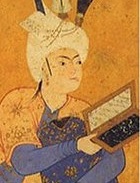first edition
1620 · Leipzig,
by HILDEBRAND, Wolfgang (ca. 1571/2-ca.1635).
Leipzig,: Henning Grossen des Jungern, 1620., 1620. Three parts in one volume. Sm. 4to. 222 pp. (the final 4 pages in sympathetic facsimiles). Collation: a-d4, A-Dd4, Ee4. Title printed in red & black. Dedication poem by Henning Dedekind, woodcut portrait of the author (facing b1), 7 woodcuts (see pages 42, 48, 52, 57, 62, 66, 71), folding astrological chart with the sun at center (facing p. 40), astrological chart of the solar system (p.77). Some leaves slightly trimmed with some loss at bottom margin, general tanning of leaves throughout. Modern half-calf, 4 raised bands, leather gilt-stamped spine label, marbled boards, new endleaves. NOTE: last 4 pages in facsimile. RARE. Early edition of Hildebrand's popular work on natural magic, re-published many times in the 17th century. The work contains recipes and secrets relating to natural magic and the zodiac. The text is written in German, appealing to the common reader, not the predominant Latin texts that were used by readers or scholars, theologians. As the title suggests, "how every person who can only read and write can calculate for himself from the hour of his birth, with the help of the perpetual calendar compiled here, his sign, planet and foremost star under which he was born." / The first book covers all twelve signs of the zodiac. The second part, referencing the influence of Albertus Magnus, is a lunar chart paired with the zodiac, as applied to every day of the year, meaning auspicious days for various activities. The third part supplies a chart, being a perpetual calendar and the influences from the seven 'planets' [Saturn, Jupiter, Mars, Sun, Venus, Moon, and Mercury – the Earth is considered the center of the system] and reading the zodiacal meanings. The fourth part deals with Chiromancy or making prophecies by reading the palm of a hand, specifically the hand lines. / "In 1610 appeared the first edition of a work in German by Wolfgang Hildebrand on natural magic. It contains recipes for coloring the hair, improving the memory, making a man merry or melancholy. To see by night one rubs one's eyes with the blood of a bat, a prescription taken from the De mirabilibus mundi current under the name of Albertus Magnus. Other secrets are to see marvels in one's dreams, not to get intoxicated quickly, to make men seem headless or with the heads of animals – an old favorite of medieval manuals of marvelous experiments, and to sleep for three days at a stretch. [etc.]" He also published an astrological work at Erfurt in 1613 … - Thorndike, History of Magic, VII, pp. 277-278. / The Astrologia naturalis of Johannes ab Indagine and the Planeten-Buch by Wolfgang Hildebrand (fl. 1622–1631) form the basis for the conversation with Indagine (Bauer). In all three of these columns, Simplicissimus plays the role of the naïve one, who knows absolutely nothing, not even how one is to read the signs of the calendars. Zonagri reproaches him again and again because of his lack of knowledge and he mocks him, whereas Indagine adopts a very different attitude, namely he informs him very objectively about both astronomy and astrology. That is to say, in the fourth through sixth columns, we are dealing with a type of meta-text of the far left-hand column. This column is contrasted with the premises of calendar making in that left-hand column. Although Grimmelshausen has taken his astronomical and astrological knowledge verbatim from his sources, one can nevertheless ask what kind of knowledge he wanted to transmit and what function the transmission of this knowledge has within the text. Those sources of Grimmelshausen which have been traced, at least to date, show that we are dealing with a popularized scientific literature that was not on a par with the most recent investigations, but which was nonetheless widely disseminated through numerous treatises and broadsides." - Karl F. Otto, A companion to the works of Grimmelshausen, (2003), p. 181. / See: Ernst Weil, 3:103 (1625 in 3 pts.); 28:152 (1629). Zinner 4814. See also: Telle, Joachim, "Die 'Magia naturalis' des Wolfgang Hildebrand", Sudhoffs Archiv. 1976; 60(2): pp. 105-22.
(Inventory #: S14228)












![Leges Marchiarum, or Border-Laws: Containing Several Original Articles and Treaties, Made and Agreed upon by the Commissioners of the Respective Kings of England and Scotland, for the bettter [sic] Preservation of Peace and Commerce upon the Marches of Both Kingdoms: From the Reign of Henry III. to the Union of the Two Crowns, in K. James I.](https://d3525k1ryd2155.cloudfront.net/h/725/220/1644220725.0.m.jpg)